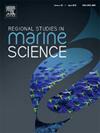Seasonal and spatial distribution of AmphiOctopus fangsiao and Octopus variabilis in the southern Yellow and East China Seas: Fisheries management implications based on climate scenario predictions
IF 2.1
4区 环境科学与生态学
Q3 ECOLOGY
引用次数: 0
Abstract
AmphiOctopus fangsiao and Octopus variabilis are economically important species that dominate the northwest Pacific cephalopod communities. However, little is known about their seasonal and spatial distributions in the southern Yellow Sea and East China Sea. This study aimed to identify the seasonal and spatial distributions of A. fangsiao and O. variabilis, explore potential relationships with environmental variables, and predict annual mean habitat variations under different climate scenarios. Our findings revealed that A. fangsiao was concentrated in the southern Yellow Sea in spring, in the Zhoushan fishing ground near the Yangtze River Estuary in summer, expanded to the entire East China Sea in autumn, and migrated offshore in winter. In contrast, O. variabilis was concentrated in the Zhoushan fishing grounds in spring, moved eastward in summer, shifted southward to the Yushan fishing grounds in autumn, and moved farther south to the Yushan-Wentai-Mindong fishing grounds in winter. Additionally, we predicted the most suitable sea bottom temperature (SBT) for A. fangsiao to be 10–25°C, with sea bottom salinity (SBS) of 29–31 ‰, whereas for O. variabilis, the most suitable SBT was 27°C, with an SBS of 34–35 ‰. Our results showed that under different climate change scenarios, the annual mean habitat area of A. fangsiao will decrease under SSP1–2.6 by 2050, and increase under SSP1–2.6 by 2100, whereas the area will shrink significantly under the SSP5–5.8 scenario by both 2050 and 2100. Moreover, the annual mean habitat of O. variabilis will shift northward offshore under SSP1–2.6 scenario by 2050 and 2100, as well as under SSP5–8.5 by 2050, but will shrink significantly under SSP5–8.5 by 2100. These results may provide guidance for sustainable fishing and management of both species by specifically incorporating climate change.
求助全文
约1分钟内获得全文
求助全文
来源期刊

Regional Studies in Marine Science
Agricultural and Biological Sciences-Ecology, Evolution, Behavior and Systematics
CiteScore
3.90
自引率
4.80%
发文量
336
审稿时长
69 days
期刊介绍:
REGIONAL STUDIES IN MARINE SCIENCE will publish scientifically sound papers on regional aspects of maritime and marine resources in estuaries, coastal zones, continental shelf, the seas and oceans.
 求助内容:
求助内容: 应助结果提醒方式:
应助结果提醒方式:


